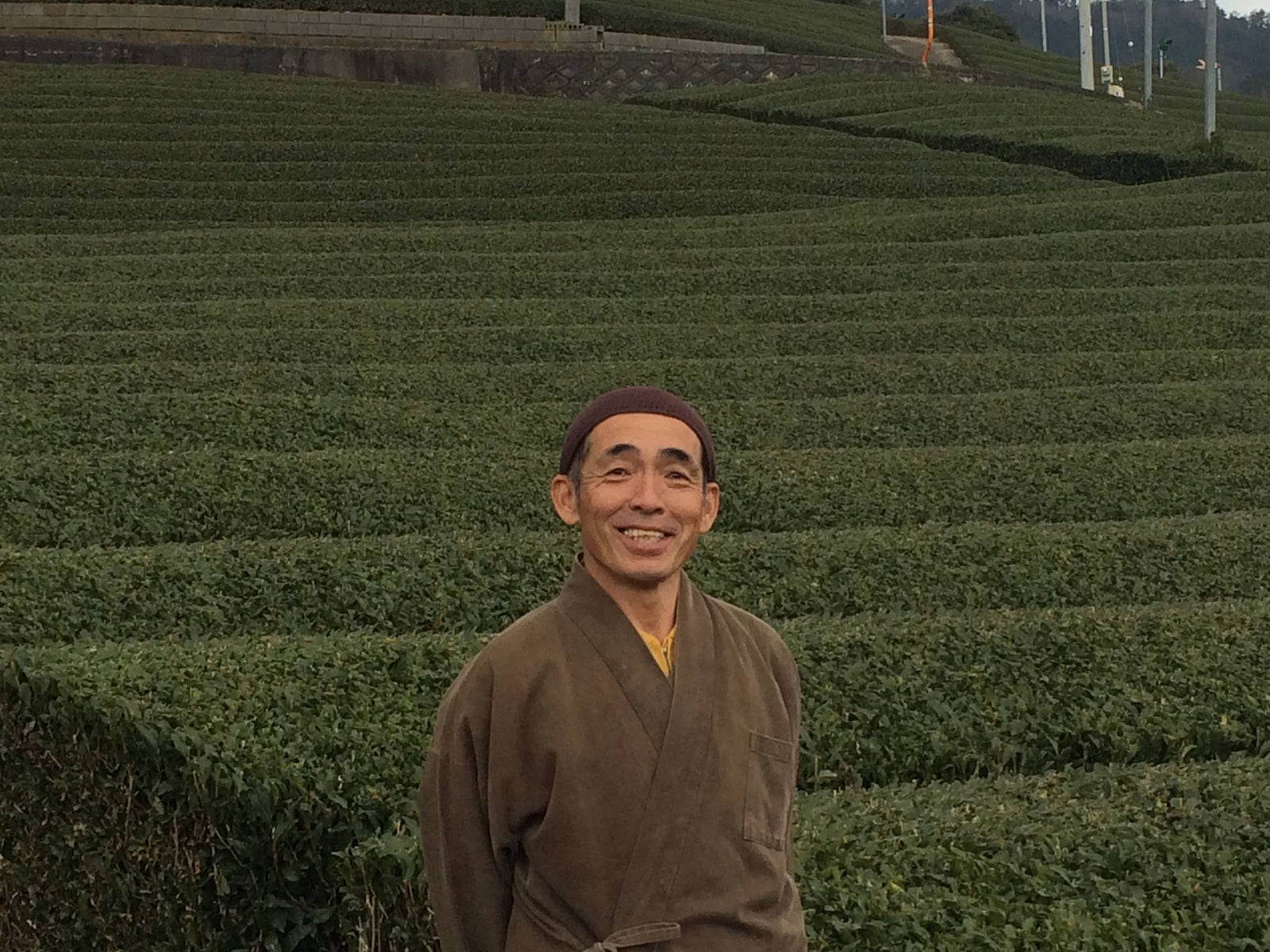京都府和束町に行ったことがあるなら、 5代目茶農家の上島則康さんの名前を聞いたことがあるかもしれません。爽緑園(上島茶園)を営む上島さんです。上島さん一家は、 和束茶カフェも経営しています。そこは、おそらく和束茶の中でも最も種類豊富な和束茶が揃った、居心地の良い空間です。私が上島さんのことを初めて知ったのは、和束町の茶畑で夏の草取りを手伝っていた時のことでした。上島さんは私たちの近くの茶畑を見下ろしていて、和束町の人たちからこう聞きました。
「そういえば、萌えちゃん、あそこにいる男性はここのお茶農家なんだよ!」
その時は何を話しているのかよく分かりませんでした。でも、上島さんの姿を見て、その存在感を感じたことは今でも覚えています。面識はなくても、和束の茶農家の方々が上島さんを尊敬しているのを感じました。今回のインタビューを通して、上島さんのお茶への情熱、和束への思い、そして勤勉さ、それら全てが、和束の産地直送茶の世界で重要な存在である理由をさらに深く知ることができました。また、上島さんのユーモアのセンス、和束なまり、話し方にも触れることができて嬉しかったです。皆さんにも上島さんについて知っていただき、彼の「おいしいお茶」をより深く味わっていただければ幸いです。
お茶の道へ:上島さんが茶農家になろうと最初に感じた直感
上島さんは22歳からお茶の道を歩み始めました。しかし、幼い頃から「お茶農家になりたい」という強い思いを抱いていたそうです。お茶農家になるまでの、ユーモラスなエピソードをご紹介します!
上島さん:中学1年生、14歳くらいの頃、父が肝臓を患って3~4ヶ月ほど入院したことがありました。父が入院していて家族で茶葉を収穫できないので、弟と二人で何かしなきゃ!って思って。でも、母が手伝ってくれても、ほとんど何もできなかったんです。近所の茶農家さんが手伝ってくれたんです。でも、やっぱり自分の茶畑の収穫が終わってから(みんな自分の畑を優先して)手伝ってくれるので、うちの茶畑はどんどん遅れていって…。弟も私も、この状況に耐えられなかったんです。
さて、これはちょっと面白い話ですが、私たちは「大八車」と呼ばれるものを作りました。 伝統的な手押し車のようなものでしょうか。弟と一緒に、茶葉を収穫するために使う予定だった手押し車に2組のハサミを載せて、興奮しながら言いました。
「よし!お茶摘みに行こう!!」
でも、手押し車を持って茶畑に向かって歩いていた時、不気味な黒いカラスが私たちに向かって「クラ、クラ」と鳴き始めたんです。私たちはまだ幼かったので、カラスには本当に怖かったんです。結局、茶葉は収穫できませんでした(笑)。でも、あの茶畑を守りたいという強い思いだけは覚えています。父が畑に行けないから、何かしてあげたい、という気持ちです。
 写真はピーター・ロイドによるものです。
写真はピーター・ロイドによるものです。
上島さんのお父様は、お茶の季節に一度だけ不在になってしまいました。兄との手押し車事件は失敗に終わりましたが、この事件の後、上島さんは15歳の時、お茶の道に進む第一歩を踏み出しました。4年制の農業高校に進学し、お茶を専門に学ぶことを決意したのです。お茶は楽しくて面白いと感じていました。そして、先代たちの努力によって茶畑が拡大してきたことから、家業の茶園を守りたいという思いが強く、自分もその道を歩みたいと強く願っていました。
オーダーメイドのお茶を淹れる喜び
昭和52年(1977年4月):上島さんは22歳で家業の茶園を手伝い、お茶の世界に入りました。まだ事業を継ぐ前でしたが、お客様に直接お茶を販売するようになった経緯を聞かせてくれました。
上島さん:私は5代目の茶農家ですが、4代目(つまり父)までは、みんなお茶を競りや市場に持ち込むだけで、卸売りしかしていませんでした。だから、お茶の道に進んでから、
「なぜ顧客に直接販売できないのか?」
農協にお茶を持って行って売ってもらうだけでは、あまり面白くないと思ったんです。当時はまだ、お茶の仕事を自分でやれる権限があまりなかったんです。でも、父にお茶を分けてもらって、自分で売ってみないかと頼みました。お茶を小さな袋に入れて売ってみたら、父は「好きにやればいい」と言ってくれました。それで、今で言うフリーマーケットみたいなところで、自分で作ったお茶を売ってみることにしたんです。奈良の元興寺に行ったのが、たぶん初めての試みだったと思います。でも、最初は全然売れなくて…
正直に言うと、私はとにかくお茶が好きでした。だから先祖、父の跡を継ごうと決めたんです。そして、父を助けたいとも思っていました。当時はそういう思いが強くありました。もちろん、全てが楽だったわけではありません。小さなティーバッグを一人で売っていた頃は、全てが順調だったわけではありません。でも、私のお茶を買ってくれたある女性が「美味しいお茶です」と言ってくれたことが、私の救いになりました。それからお茶との対話が始まりました。お客様がどんなお茶を飲みたいか尋ねると、彼らは私に教えてくれました。そして、自分でお茶を売ることで、お客様の声を聞き、お客様が喜ぶお茶を作ることができると気づいたんです。そこに喜びを見出したのです。

お客様との対話や直接販売の経験から、上島さんは今も常にお客様のことを第一に考えながらお茶を淹れています。オーダーメイドのお茶作り、無農薬・無化学肥料、国内で手に入る資源を使ったお茶作り、そして環境に配慮したお茶作りを楽しんでいます。今後の茶業とビジネスのビジョンを伺うと、上島さんは「すべてのお茶を、お茶を求める人々の手に直接届けたい」とおっしゃいました。お客様が求めるお茶を淹れること以上に、上島さんにとって大切なことは何もないのです。
茶農家としての勤勉さ
萌:上島さんの仕事ぶりから感じるのは、勤勉さですね。お父様とあなたはお茶の仕事で、おそらく過重労働も含めて、数え切れないほどの時間を働いてこられたそうですね。病気になったり、仕事で燃え尽きてしまったりした時期はありましたか?
上島さん:そうですね、茶畑で体を壊したり、病気になったりしたことはないんです。ただ、一度だけ胃潰瘍になったことがあって、胃に3つも穴が開いてしまったんです…。
30代前半だったと思います。驚かれるかもしれませんが、鉄道ってご存知ですか?踏切がありますよね?線路の下にブロックがあるんですが、その下のブロックを交換する作業をしていました。これは一年中できる仕事ではなくて、暖かい季節はあまり仕事がないんです。でも11月から3月くらいまでは需要が高いんです。それで、どういうことかというと…その日の終電が終わると、この作業員は「よし、始めよう!」ってことで、線路の釘を全部外して、下のレールとブロックを外すんです。それからブロックを元に戻して、線路を敷いて、また釘を打ち込む。それが10年くらい続いた夜のアルバイトでした。
では、なぜそんな仕事をしていたのか。それは父のおかげと言ってもいいかもしれません。和束町で茶農家として生き残るには、茶畑を増やすことが必要でした。それが我が家の最大の目標でした。しかし、私たちは20代ほど続く大代茶農家の分家だったので、もともと土地があまりありませんでした。もっとお茶を淹れるには茶畑が必要で、そのためには土地を買うか借りるしかありませんでした。だから、私たちが成功するには、何か他の人とは違うことをしなくてはならない、と父はよく言っていました。
高校生の頃、父も同じことをしていました。他の茶農家のように朝から働くのではなく、日中に茶畑で働き、夕食を食べてお風呂に入り、それから鉄道工事に行く準備をしていました。線路には午前0時前に到着します。そして、鉄道工事は午前4時~5時頃に終わり、7時~8時頃に帰宅して寝て、正午(正午)に起きて茶畑へ行き、半日働く…これを繰り返していました。こうして生計を立て、貯金してまた茶畑を買うことができたのです。これが私たちの家系です。鉄道工事が比較的近い時期には、私も実家に帰ることができました。しかし、仕事が忙しい時期には、四国、高松、高知、徳島など、日本各地を転々としていました。この時期は仕事が忙しく、お腹に3つの穴が開いたんです(笑)。
実は、それは現場での出来事でした。ある夜、夜勤中に私は思いました。
「うわ、本当に気分が悪い」と言いながら、その場で文字通り倒れてしまいました。翌日、地元の病院に行ってレントゲンを撮ったら、すぐに大きな病院に送られました。そして、病院に着くと、3つの穴が開いていることがわかりました。その週は比較的安静に過ごし、休養しました。
鉄道の夜間作業はご存知の通り、とても寒かったんです。特に冬場は零下になるんです。皆が寝ている間に働き、少しずつ前進していると信じていました。父もそう考えていました。もっと楽な道があるかもしれないけれど、私たちは不器用なので、それが私たちの戦略だったんです(笑)。だから私は諦めずに続け、それが30代の私の仕事の日々のルーティンでした。ええ、確かにみんなに笑われたり、からかわれたりしました。「奥さんがいるのに夜は家にいないんだ」なんて言われたりもしました(笑)。
でも、あの苦労の日々があったからこそ、今の私があるんです。今ではお茶業界で尊敬される存在です。 「私は唯一のミスター・パーフェクト」です(笑)。もしかしたら、ちょっと自慢しすぎかもしれませんが…でも、西洋人にとって自慢するのは普通のこと、彼らはそれを「昇進」とか言うらしいですよ。
※上記のミスター・パーフェクトのコメントを詳しく説明すると、京都で90年以上続くお茶の味覚コンテストで、上島さんは満点を獲得した唯一の優勝者です。

以下に実際の数字を示しながら、上島さんのご家族が長年にわたり茶畑をどのように拡大してきたかをご覧ください。現在、茶畑の管理は3人の農家が担っています。上島さんは通常、繁忙期には2人の従業員を雇い、最盛期には奥様も収穫作業を手伝っていただいています。
初代 - 300*坪( 0.099ha )
*坪は日本で標準化された畳2枚分の面積で、現在でも一般的に使われている単位です。
第2世代- 0.25ヘクタール
第3世代- 0.5ヘクタール
父の世代- 1.5ヘクタール
- 上島さんのお父さんは、開墾(かいこん)をして田んぼを茶畑に変え、耕作面積を1.5ヘクタールまで広げました。
上島さん - 4ha
- 上島さんは父親の努力を引き継ぎ、現在では和束だけでなくその周辺地域にも約4ヘクタールの茶畑を所有し、京鍋(てん茶、玉露)、賀茂(かぶせ茶)、和束(かぶせ茶、煎茶)、井手といった特定の種類のお茶を栽培しています。
Moé:好奇心からですが、茶園で一番楽しい時間はありますか?
上島さん:和束町の9月は、本当に素敵な時期なんです。秋の新茶の収穫期前の時期が、本当に茶畑が好きなんです。もしかしたら、一番茶の時期だと思っていらっしゃるかもしれませんね!この時期も好きなんですが、この時期はまさに戦士モードなので、なかなか茶畑をじっくり味わう気分になれないんです。毎日、次に何をすべきか、戦略的に計画を立てているんです(笑)。だから誤解しないでほしいんですが、 新茶の時期もいいとは思いますが、9月頃の方がより楽しめるんです。
「茶の間」を体現する
 写真は和束町にある和束茶カフェより。
写真は和束町にある和束茶カフェより。
萌え: 私たちは茶農家とお客様を繋ぐために最善を尽くしたいと思っていますので、最後にYunomiのお客様へメッセージをいただけますか?
上島さん:いつもお茶を飲んでくださってありがとうございます(微笑) 。日本茶はとても健康に良いので、たくさん飲んで健康に過ごしてくださいね。それが私の一言です。そして、 「茶の間」という時間を大切にしてほしいですね。
難しい表現かもしれませんが、お茶を淹れ、淹れ、盛り付け、そして飲むまでの過程を指します。日本には古くから「茶の間」という伝統的な言い回しがあります。日本語には「間」という言葉があります。
お茶を淹れる「間」。
コミュニケーションの「間」とは…
茶の間とは、お客様を自宅に招き、目の前でお茶を点てあげる特別な方法です。和束では、ゆったりとした交流の場を創り出すおもてなしの精神が根付いています。Yunomiのお客様にも、茶の間のための空間を作り、この茶の間を体現していただきたいと思っています。そして、ご家族やご友人と茶の間を共有していただければと思います。
多くの外国人は、日本ではお茶は食後に自由に出されるものだと考えています(一部のレストランではそうかもしれません)。しかし、日本茶はそれだけではありません。私たちが「茶の間」と呼ぶ空間には欠かせない要素です。お茶は中心となるものです。私たちはお茶を通して、コミュニケーションの場を創り、コミュニケーションのきっかけを作ります。ですから、私のお茶を飲んでくださる方、日本茶を飲んでくださる方に、お茶を通して良い在り方、良い生き方を感じていただければと思っています。
Moé:この件については、これまでの茶農家へのインタビューでは触れられていなかったので、取り上げていただいて嬉しいです。
上島さん:そうですね、「茶」という言葉は日本語の日常会話でよく使われます。 「茶の間」だけではなく、 「無茶苦茶(むちゃくちゃ)」とか、 「お茶目(ちゃめ)」とか、日常会話で使いますよね。日本ではお茶が日常生活に深く根付いているのが分かりますね。長い間、社会は早く物事をすることが成功だと考えてしまい、私たちは物事をゆっくり行うことを忘れてしまっています。シンプルな暮らしを楽しむ。人々は時間がないように見えます。でも、ほんの少しの時間、空間、そして気遣いを作ることができるのだと示せたら、伝えられたら…そうすることで、少し違う世界を創り出すことができるのだと。それを伝えていきたいです。時間をかけて急須でお茶を淹れること。そして、自分のためだけでなく、他の人のためにも、お茶を淹れるプロセスを楽しんでほしい。だって、お茶って喉が渇いたときに飲むものじゃないでしょ?
喉が渇いたら水を飲みますよね。私たちが淹れるお茶は、喉の渇きを癒すためのものではありません。ご存知ですよね(笑)。ところで、お茶についてあれこれお話した後は、いつも最後にこう締めくくります。「では、お客様にはどんなお茶を飲んでいただきたいですか?」と。私のお茶の決め台詞は、「喉が渇いたら水を飲む」です。でも、私が淹れるお茶は、心が渇いた時に飲むお茶です(笑)。
萌え: 素晴らしい!上島さん、全部完璧にこなしていますね(笑)。
もしかしたら、上島さんのお茶は、今の私たちの心の渇きを癒してくれるのかもしれません… 上島さんの語り口とユーモアセンスを、私と同じくらい楽しんでいただけたら嬉しいです。インタビュー中、上島さんから和束茶カフェの歴史についても詳しくお聞きしましたので、近日公開予定の主要茶産地「和束」の記事で、その情報もお伝えできればと思っています。お元気で、お茶を飲み、お茶を分かち合う時間と空間を、共に楽しむ時間を過ごしてくださいね。
※注:本記事の写真は、特に記載がない限り、上島茶園のものを使用しています。上島さんのお茶にご興味をお持ちの方は、 こちらからご覧いただけます。



1件のコメント
Very nice article and lovely introduction to Uejima-san. I appreciate his values and goals.